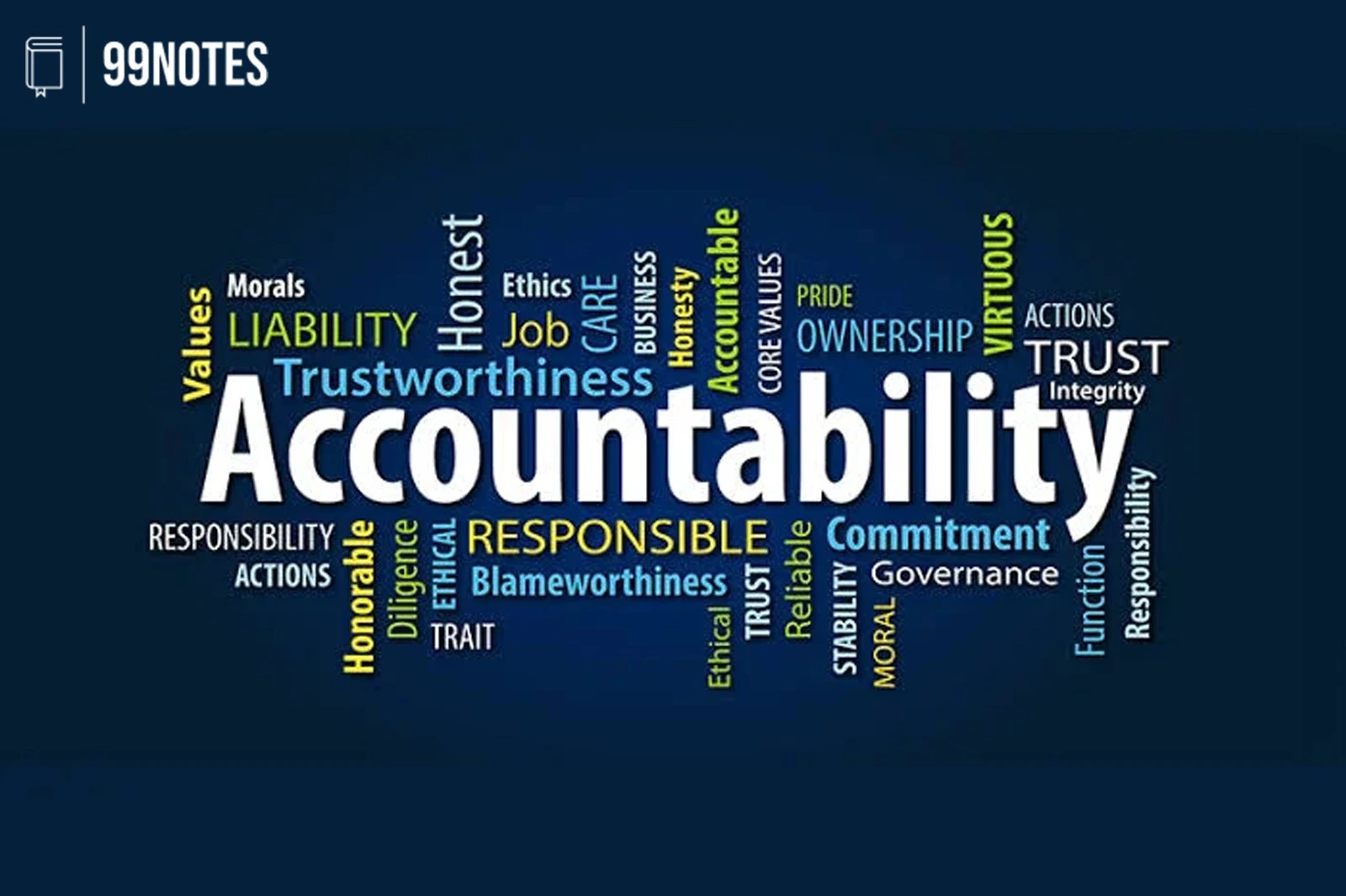Accountability
Accountability ensures those in positions of power or decision-making are held responsible and answerable for their actions. Ethics in governance is required for a welfare society. To contribute to a better society in terms of freedom, equality, fraternity, and social justice, the body of governance needs to inculcate ethics and moral values through society, education, family, friends, etc.
What is Accountability?
It is defined as the answerability to one’s actions and decisions against the laws, conventions, and even other values.
- Accountability comes into the picture after the action has been performed and when the government or civil servant has taken the action. Then the decision will be scrutinized as per the legal process and procedures.
- Mostly the issue of accountability is linked with corruption and that’s why Lord Acton also said that ” power corrupts and absolute power corrupts absolutely ”
- Often Accountability is misunderstood as Responsibility.
- Responsibility is an inner concept like your responsibility to do some work.
- Accountability is an outer concept like your accountability for some work you have done.
- Let’s understand with an Example.
A special court of the Central Bureau of Investigation has sentenced former Uttar Pradesh chief secretary Neera Yadav to four years imprisonment after finding her guilty in a 2002 land allocation case.
The charges pertain to the illegal allocation of commercial plots in Noida while Yadav, a 1971 batch IAS officer, was the chief executive of the New Okhla Industrial Development Authority.
She was sentenced to rigorous imprisonment for misusing her official powers as an IAS officer. This is a classic case of lack of accountability which is prevailing among civil servants and has dire consequences on the nation.
Types of Accountability
There can be two types of Accountability in Governance:
- Vertical Accountability: Accountability towards someone above us in terms of power. For example, the government is answerable to the public. It means the public is above the government.
This accountability is ensured by: Elections, RTI, Media & Social Media, Citizens Charter, NGO and Pressure Groups.
In India, the Flow of accountability is as follows: The permanent executive is answerable to the Elected government, which is accountable to the Parliament, which in turn is accountable to the Electorate.
- Horizontal Accountability: Accountability of Public Institutions/Servants to Government. Generally, this accountability serves as checks and balances, so that the power does not concentrate in a few areas of the government. Horizontal accountability can be of two types:

- External Accountability: Accountability of Public Servant outside his wing. It involves tools like independent investigation, auditing and Judicial checks.
-
-
-
- Accountability of Minister (Executive) to Parliament (Legislature)
- Judiciary
- CAG
-
-
- CVC
- NHRC
- Internal Accountability: Accountability of Public Servants inside their wing/department. This generally is ensured through appraisal reports etc.
- Accountability to Superiors
- Internal Audit
- Grievance Redressal Mechanisms
| In the case of corporations, Internal Accountability is ensured by the board of directors, and by the shareholders in the annual general meeting (AGM). The external accountability is established by the submission of statements and reports to the corporate ministry, SEBI, and other regulatory agencies and the Auditor of the company. |
Importance of Accountability
- Promotes Transparency – Ensures openness in decision-making, allowing stakeholders to assess governance effectiveness. For example, electoral funding disclosures make political party finances more transparent, reducing corruption risks.
- Enhances Performance – Clear accountability measures lead to better efficiency. For example, performance-based assessments of government schemes like the Aspirational Districts Programme ensure targeted development.
- Prevents Corruption – Strengthens ethical governance by deterring misconduct. Regular answerability prevents corruption even before happening. For example, whistleblower protection laws encourage reporting of corruption while ensuring the safety of informants.
- Builds Public Trust – When institutions remain accountable, people develop trust in governance. For instance, Supreme Court judgments on public interest litigations (PILs) demonstrate judicial accountability, reinforcing faith in the legal system.
- Ensures Responsibility – Holds individuals and organizations answerable for their actions. For example, municipal corporations being accountable for waste management ensures cleaner cities and better public health.
- Improves Decision-Making – Accountability mechanisms like audits and evaluations enhance governance. For instance, public consultations before drafting key laws, such as environmental regulations, ensure well-informed decision-making.
- Protects Rights – Prevents power abuse and safeguards rights. For example, police accountability mechanisms, such as independent review boards, help prevent custodial violence and ensure justice.
Ensuring Accountability in Governance: Strategies and Examples
Accountability in governance is crucial for the development, trust, and integrity of any democratic society. It involves various mechanisms, strategies, and practices aimed at making government officials and institutions answerable and responsible for their actions.
We can ensure accountability in governance in the following ways:
- Legislative Oversight: Legislative bodies have the power to oversee government actions, ensuring they align with laws and policies. This includes questioning government officials, conducting inquiries, and reviewing government spending and policy implementation.
Example: In India, the Parliament exercises oversight through various committees like the Public Accounts Committee (PAC), which examines the expenditure and performance of the government as reported by the Comptroller and Auditor General (CAG) of India.
- Judicial Review: Courts have the authority to review the actions of the executive and legislative branches to ensure they comply with the Constitution and laws. Example: The Supreme Court of India and High Courts have often exercised their power of judicial review to strike down laws and executive decisions that were found unconstitutional, thereby ensuring accountability.
- Audits and Financial Controls: Regular audits of government finances and projects by independent bodies can ensure that public funds are used appropriately and efficiently. Example: The Comptroller and Auditor General (CAG) of India conducts audits on all expenditures from the Consolidated Fund of India, ensuring accountability in financial matters.
- Right to Information: Laws that allow citizens to request information from the government promote transparency and accountability by making government operations more open. Example: The Right to Information Act, of 2005, has been a powerful tool in India, enabling citizens to seek information about government activities, thereby promoting transparency and accountability.
- Decentralization: Decentralizing power, by delegating authority to local governments, can make governance more responsive and accountable to local communities. Example: The 73rd and 74th Constitutional Amendments in India aimed at strengthening local governance (Panchayati Raj Institutions and Urban Local Bodies) by providing them with a constitutional status for governance closer to the grassroots level.
- Civil Society and Media: A vibrant civil society and a free press can play a critical role in holding the government accountable by investigating, reporting, and critiquing government actions. Example: Civil society organizations and investigative journalists in India have played pivotal roles in exposing corruption and advocating for reforms, such as the campaign for the Right to Information Act.
- Whistleblower Protections: Protecting individuals who report illegal or unethical actions within the government encourages more people to come forward with information about misconduct. Example: The Whistle Blowers Protection Act, of 2014, in India is aimed at protecting individuals who expose corruption or willful misuse of power by public servants, including ministers.
- Performance Evaluations: Regular performance evaluations of government agencies and officials can help assess effectiveness, identify areas for improvement, and hold entities accountable for their results. Example: The Performance Management Division under the Cabinet Secretariat of India works towards improving government performance through various initiatives, including the Results-Framework Document (RFD) system for evaluating departmental performances.
Ensuring accountability in governance is a multifaceted approach that requires the concerted effort of government institutions, civil society, and citizens. It is fundamental to maintaining the trust of the public in their government and ensuring that governance is conducted in an efficient, transparent, and ethical manner.
The existing problems and weaknesses
In the traditional concept of accountability, ethics is missing from the enforcement of accountability.
- The ethical standards are missing, leading to a lack of substantial aspects of accountability in the administration.
- For instance, police arresting people based on suspicion is legally justified. However, police personnel forced them to accept the commission of offence leaving the question of substantial accountability.
- Another example can be the invoking of Article 356 and the associated role of the governor in it. As it was seen that they were largely lacking substantial accountability.
- Tax officers carrying out raids are completely legal, however, if they are targeting some sections of people question the ethical standards and the substantial aspect of accountability.
Changes made to overcome these issues
The traditional concept showed signs of a gap between the concept of accountability and its enforcement in letter and spirit.
- 1980s onwards there were changes made in enforcing accountability. They introduced the participation of people in the process of upholding accountability through the citizens’ charter, right to information, social auditing, and so on.
- Due to the increased participation of people transparency increased which created strong deterrence against wrongdoings.
- Because of this changed approach now the civil servants and the discretion of the administration are minimized and the room for misuse of power is narrowed down, resulting in improved responsiveness and responsibility of the civil servants towards the citizens of the country.
Way forward
Any abuse of authority should be strictly punished, and organizations responsible for accountability, such as the CAG, CVC, and CBI, should be made truly independent without any external influence.
Accountability promotes a feedback loop between the government and its constituents. As a result, accountability to citizens is vital for maintaining public trust and confidence in existing democratic processes.
To ensure responsiveness, transparency, and accountability, the element of discretionary power must be minimized.



![Swadeshi Movement (1905): Overview, Causes &Amp; Impact [Upsc Notes] | Updated April 24, 2025 Swadeshi Movement (1905): Overview, Causes & Impact [Upsc Notes]](https://www.99notes.in/wp-content/uploads/2024/01/swadeshi-movement-featured-66698a5e632b7-768x500.webp)




